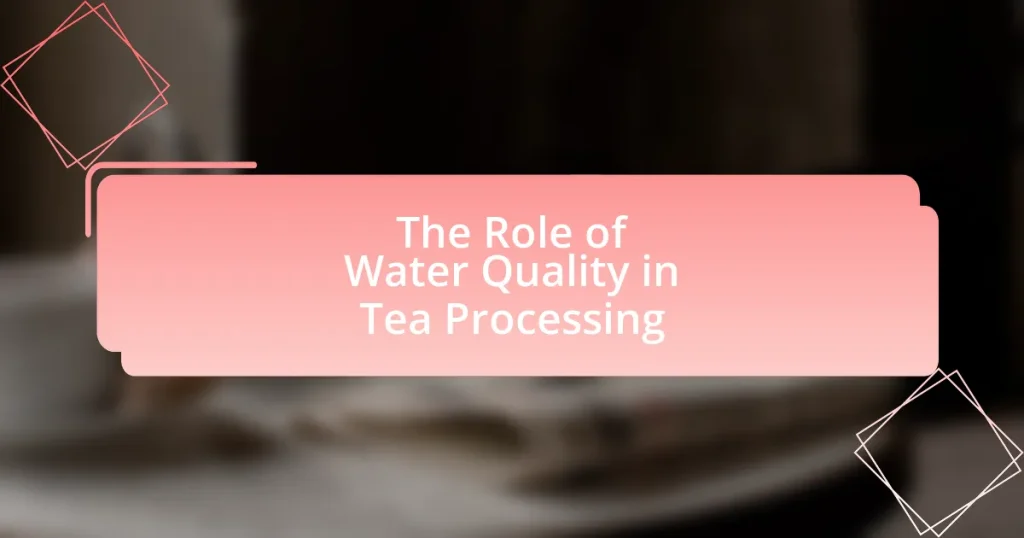The article focuses on the critical role of water quality in tea processing, emphasizing how it directly influences the flavor, aroma, and overall quality of tea. Key factors such as mineral content, pH levels, and the presence of contaminants are discussed, highlighting their impact on the extraction of essential compounds from tea leaves. The article also addresses the importance of maintaining high water quality to ensure the health benefits of tea and outlines best practices for sourcing and testing water. Additionally, it explores the challenges faced by tea producers in maintaining optimal water quality and offers practical strategies to overcome these issues.

What is the Role of Water Quality in Tea Processing?
Water quality plays a crucial role in tea processing as it directly affects the flavor, aroma, and overall quality of the tea. High-quality water, characterized by low mineral content and absence of contaminants, ensures that the natural characteristics of the tea leaves are preserved during extraction. Studies indicate that water with high levels of chlorine or other impurities can lead to undesirable flavors and aromas, negatively impacting the final product. Furthermore, the pH level of water influences the extraction of essential compounds from tea leaves; optimal pH levels enhance the extraction of polyphenols and caffeine, which are vital for the tea’s taste and health benefits. Therefore, maintaining high water quality is essential for producing premium tea.
How does water quality impact the flavor of tea?
Water quality significantly impacts the flavor of tea by influencing its extraction and overall taste profile. The mineral content, pH level, and presence of impurities in water can alter how flavors are released from tea leaves. For instance, water with high mineral content, particularly calcium and magnesium, can enhance the extraction of flavor compounds, resulting in a richer taste. Conversely, water that is overly soft or contains high levels of chlorine can lead to a flat or undesirable flavor profile. Studies have shown that the ideal water for brewing tea typically has a balanced mineral composition, with a pH around neutral, which optimally extracts the aromatic compounds and essential oils from the tea leaves, thereby enhancing the overall flavor experience.
What specific water characteristics influence tea flavor?
The specific water characteristics that influence tea flavor include mineral content, pH level, and temperature. Mineral content, particularly calcium and magnesium, can enhance the extraction of flavor compounds from tea leaves, while a balanced pH level, ideally around neutral (6.5 to 7.5), prevents bitterness and promotes sweetness. Temperature affects the solubility of flavor compounds; higher temperatures generally extract more flavors but can also lead to over-extraction if too high. Studies have shown that water with high mineral content can improve the overall taste profile of tea, as evidenced by research indicating that water with a hardness level of 100-200 mg/L is optimal for brewing.
How do different water sources affect tea taste?
Different water sources significantly affect tea taste due to variations in mineral content, pH levels, and impurities. For instance, water with high mineral content, such as calcium and magnesium, can enhance the flavor and aroma of tea, while soft water may result in a flat taste. Research indicates that water with a pH around 6.5 to 7.5 is optimal for brewing tea, as it allows for better extraction of flavors. Additionally, water sourced from natural springs often contains beneficial minerals that contribute positively to the overall taste profile of the tea. Conversely, chlorinated tap water can impart undesirable flavors, negatively impacting the tea’s quality.
Why is water quality important for tea processing?
Water quality is crucial for tea processing because it directly affects the flavor, aroma, and overall quality of the tea. High-quality water, free from contaminants and with balanced mineral content, enhances the extraction of essential compounds from tea leaves, resulting in a superior brew. Studies have shown that water with high levels of chlorine or heavy metals can negatively impact the taste and safety of the final product. For instance, research indicates that water with appropriate mineral content can improve the extraction of catechins and amino acids, which are vital for the tea’s flavor profile. Thus, ensuring optimal water quality is essential for producing high-quality tea.
What are the potential consequences of poor water quality in tea production?
Poor water quality in tea production can lead to significant negative impacts on both the quality of the tea and the health of consumers. Contaminated water can introduce harmful pathogens and chemicals, resulting in tea that may pose health risks, such as gastrointestinal illnesses or exposure to toxic substances. Additionally, poor water quality can affect the taste and aroma of the tea, leading to subpar flavor profiles that do not meet market standards. Research indicates that water with high levels of pollutants can alter the chemical composition of tea leaves, diminishing their antioxidant properties and overall quality. This can ultimately result in economic losses for producers due to decreased consumer demand and potential recalls.
How does water quality relate to the health benefits of tea?
Water quality significantly impacts the health benefits of tea by influencing the extraction of beneficial compounds during brewing. High-quality water, characterized by low levels of contaminants and balanced mineral content, enhances the solubility of antioxidants, polyphenols, and other bioactive compounds in tea. For instance, studies indicate that water with appropriate mineral content, such as calcium and magnesium, can improve the flavor and health properties of tea, leading to better absorption of these beneficial compounds in the body. Conversely, poor water quality, which may contain chlorine or heavy metals, can diminish the tea’s health benefits and introduce harmful substances, thereby negating the positive effects associated with tea consumption.

What are the key components of water quality in tea processing?
The key components of water quality in tea processing include pH level, mineral content, dissolved oxygen, and microbial load. The pH level affects the extraction of flavors and compounds from tea leaves; optimal pH for tea processing typically ranges from 6 to 7. Mineral content, particularly calcium and magnesium, influences the taste and mouthfeel of the tea, with specific ratios enhancing flavor profiles. Dissolved oxygen is crucial for oxidation processes during fermentation, impacting the aroma and color of the final product. Lastly, microbial load must be controlled to prevent spoilage and ensure safety, as high levels can lead to undesirable flavors and health risks. These components collectively determine the overall quality and characteristics of the tea produced.
What are the essential minerals and elements in water for tea?
The essential minerals and elements in water for tea include calcium, magnesium, potassium, and sodium. These minerals contribute to the overall flavor, aroma, and quality of the tea. Calcium enhances the sweetness and body of the tea, while magnesium is crucial for the extraction of flavor compounds. Potassium helps balance the taste, and sodium can enhance the overall mouthfeel. Studies have shown that water with a balanced mineral composition can significantly improve the brewing process and the sensory attributes of the tea, making these minerals vital for optimal tea preparation.
How do minerals like calcium and magnesium affect tea extraction?
Minerals like calcium and magnesium significantly influence tea extraction by affecting the solubility of compounds in tea leaves. Calcium ions can enhance the extraction of flavor compounds and polyphenols, leading to a richer taste profile. Magnesium, on the other hand, plays a crucial role in the extraction of catechins, which are important for the tea’s antioxidant properties. Studies have shown that water with higher concentrations of these minerals can improve the overall quality of the brewed tea, as they facilitate the release of essential oils and flavors from the leaves. For instance, research indicates that water with a balanced mineral content can enhance the sensory attributes of tea, making it more aromatic and flavorful.
What role does pH play in the brewing process?
pH plays a crucial role in the brewing process by influencing the extraction of flavors and compounds from tea leaves. The optimal pH range for brewing tea is typically between 6 and 7, which allows for the best balance of flavor, aroma, and color. When the pH deviates from this range, it can lead to undesirable flavors; for instance, a lower pH (more acidic) can enhance bitterness, while a higher pH (more alkaline) can result in a flat taste. Studies have shown that water with a pH outside the optimal range can negatively affect the overall quality of the brewed tea, impacting both the sensory experience and the health benefits associated with tea consumption.
How does water temperature interact with water quality in tea processing?
Water temperature significantly influences water quality during tea processing by affecting the solubility and extraction of compounds from tea leaves. Higher temperatures can enhance the extraction of flavors, aromas, and beneficial compounds like catechins and amino acids, but they may also lead to the extraction of undesirable bitter compounds if the temperature exceeds optimal levels. Research indicates that water temperatures between 80°C to 90°C are ideal for green tea, while black tea benefits from boiling water at 100°C, demonstrating that the interaction between temperature and water quality is crucial for achieving the desired flavor profile and health benefits in tea.
What is the ideal temperature range for different types of tea?
The ideal temperature range for different types of tea varies significantly. Green tea is best brewed at 160-180°F (71-82°C), while white tea should be steeped at 160-185°F (71-85°C). Oolong tea requires a temperature of 190-200°F (88-93°C), and black tea is ideally brewed at 200-212°F (93-100°C). Herbal teas can be steeped at boiling point, around 212°F (100°C). These temperature ranges are crucial for extracting the optimal flavors and health benefits from each type of tea, as higher temperatures can lead to bitterness in delicate teas like green and white, while lower temperatures may not fully extract the flavors in robust teas like black.
How does temperature affect the extraction of flavors from tea leaves?
Temperature significantly influences the extraction of flavors from tea leaves, with higher temperatures generally leading to more efficient flavor release. When water temperature increases, it enhances the solubility of various compounds in tea leaves, such as catechins, amino acids, and essential oils, which contribute to the overall flavor profile. For instance, brewing green tea at lower temperatures (around 70-80°C) preserves delicate flavors and prevents bitterness, while black tea benefits from higher temperatures (around 90-100°C) to fully extract robust flavors. Studies indicate that optimal extraction occurs within specific temperature ranges, demonstrating that temperature control is crucial for achieving desired flavor characteristics in tea.

How can tea producers ensure optimal water quality?
Tea producers can ensure optimal water quality by regularly testing water sources for contaminants and maintaining proper filtration systems. Regular testing allows producers to identify harmful substances such as heavy metals, pesticides, and microbial pathogens that can affect tea quality. Implementing advanced filtration methods, such as reverse osmosis or UV treatment, can effectively remove these contaminants, ensuring that the water used in tea processing is pure and safe. Studies have shown that water quality directly influences the flavor and aroma of tea, with high-quality water contributing to a superior final product.
What methods can be used to test water quality for tea processing?
Methods to test water quality for tea processing include chemical analysis, microbiological testing, and physical testing. Chemical analysis assesses parameters such as pH, hardness, and dissolved solids, which are crucial for flavor extraction and overall tea quality. Microbiological testing identifies harmful bacteria and pathogens that could affect health and product safety. Physical testing evaluates turbidity and color, which can influence the visual appeal of the tea. These methods ensure that the water used meets the necessary standards for optimal tea production, as poor water quality can lead to undesirable flavors and health risks.
What are the common water quality tests relevant to tea production?
Common water quality tests relevant to tea production include pH level, electrical conductivity, total dissolved solids (TDS), hardness, and microbial contamination. These tests are essential as they directly influence the growth of tea plants and the quality of the final product. For instance, the pH level affects nutrient availability in the soil, while electrical conductivity and TDS indicate the concentration of salts and minerals, which can impact flavor and aroma. Hardness tests measure calcium and magnesium levels, which are crucial for plant health. Additionally, testing for microbial contamination ensures that the water used is safe and does not introduce pathogens that could harm the tea plants or affect the quality of the tea.
How can producers interpret water quality test results?
Producers can interpret water quality test results by analyzing specific parameters such as pH, turbidity, dissolved oxygen, and the presence of contaminants. These parameters indicate the suitability of water for tea processing; for instance, a pH level between 6.0 and 7.5 is ideal for tea, while high turbidity can affect the clarity and taste of the final product. Additionally, understanding the levels of contaminants like heavy metals or pesticides is crucial, as these can impact both the safety and quality of the tea. Regular testing and comparison against established standards, such as those from the World Health Organization, provide a reliable framework for producers to assess water quality effectively.
What best practices should tea producers follow regarding water quality?
Tea producers should ensure that water used in tea processing is clean, free from contaminants, and has optimal mineral content. Clean water prevents the introduction of harmful substances that can affect the flavor and safety of the tea. Regular testing of water sources for microbial contamination, pH levels, and mineral content is essential to maintain quality. For instance, water with a pH between 6.5 and 7.5 is ideal for tea production, as it supports the extraction of flavors without altering the tea’s chemical properties. Additionally, using filtered or treated water can help eliminate impurities, ensuring a consistent and high-quality product.
How can filtration systems improve water quality for tea processing?
Filtration systems can significantly improve water quality for tea processing by removing impurities and contaminants that affect flavor and safety. These systems utilize various technologies, such as activated carbon filters and reverse osmosis, to eliminate chlorine, sediment, and microorganisms, ensuring that the water used in tea preparation is clean and free from unwanted substances. Research indicates that using filtered water can enhance the extraction of flavors and aromas from tea leaves, leading to a superior final product. For instance, a study published in the Journal of Food Science found that water quality directly influences the sensory attributes of brewed tea, highlighting the importance of filtration in achieving optimal taste and quality.
What are the recommended practices for sourcing water for tea production?
The recommended practices for sourcing water for tea production include selecting clean, fresh water sources that are free from contaminants and pollutants. Water quality directly impacts the flavor and aroma of tea, making it essential to use water with low mineral content and balanced pH levels, ideally between 6.5 and 7.5. Additionally, sourcing water from natural springs or deep wells is preferred, as these sources typically have better filtration and lower levels of harmful substances. Regular testing of water quality for microbial contamination and chemical pollutants is crucial to ensure safety and maintain the integrity of the tea. Studies have shown that water quality can significantly influence the extraction of flavor compounds during brewing, underscoring the importance of these practices in tea production.
What are the common challenges in maintaining water quality in tea processing?
Common challenges in maintaining water quality in tea processing include contamination from agricultural runoff, inadequate filtration systems, and inconsistent water pH levels. Contamination from agricultural runoff can introduce pesticides and fertilizers into the water supply, negatively impacting the tea’s flavor and safety. Inadequate filtration systems may fail to remove harmful microorganisms and particulates, leading to potential health risks. Additionally, inconsistent water pH levels can affect the extraction of flavors and compounds during processing, ultimately influencing the quality of the final tea product. These factors collectively pose significant hurdles in ensuring optimal water quality for tea processing.
How can environmental factors affect water quality for tea?
Environmental factors significantly affect water quality for tea by influencing the chemical composition and physical properties of the water used in tea cultivation and processing. For instance, factors such as soil composition, rainfall patterns, and temperature can alter the levels of minerals and contaminants in water sources. High levels of pollutants from agricultural runoff, such as pesticides and fertilizers, can degrade water quality, leading to adverse effects on tea flavor and health benefits. Research indicates that water with high mineral content, particularly calcium and magnesium, can enhance the taste profile of tea, while excessive levels of heavy metals can be detrimental. Therefore, maintaining optimal environmental conditions is crucial for ensuring high-quality water for tea production.
What strategies can be implemented to overcome water quality issues?
To overcome water quality issues in tea processing, implementing filtration systems, regular water quality testing, and using water treatment technologies are essential strategies. Filtration systems, such as activated carbon filters, can remove impurities and contaminants, ensuring cleaner water for tea production. Regular testing of water quality helps identify specific contaminants, allowing for targeted treatment solutions. Technologies like reverse osmosis and UV disinfection can effectively eliminate harmful microorganisms and chemical pollutants, thus enhancing the overall quality of water used in tea processing. These strategies are supported by studies indicating that improved water quality directly correlates with better flavor and safety in tea products.
What practical tips can tea producers implement for better water quality?
Tea producers can implement several practical tips for better water quality, including regular testing of water sources, using filtration systems, and maintaining proper storage conditions. Regular testing helps identify contaminants such as heavy metals or microbial pathogens, ensuring that the water meets safety standards for tea processing. Filtration systems, such as reverse osmosis or activated carbon filters, can effectively remove impurities, enhancing the overall quality of the water used in tea production. Additionally, maintaining proper storage conditions, such as keeping water in clean, sealed containers away from direct sunlight, prevents contamination and preserves water quality. These practices are essential for producing high-quality tea, as water quality directly influences flavor and aroma.


